No one wants to sit on the side of the road with a flat tire, but it happens. Because you want to get back on the road for as little money as possible, you might be evaluating your repair options. This might bring you to ask – can you patch a hole in the sidewall of a tire?
While a lot of tire punctures can be repaired, there are some that shouldn’t be attempted. In this guide, we talk about when you should and shouldn’t repair a tire. We also look at whether a patch is a better tire repair option than a plug.
Table of Contents
1
Can You Patch a Hole in the Sidewall of a Tire?No, if there is a leak or hole in the sidewall, you should not consider patching or plugging it. Sidewall repair should not be attempted because it can degrade the integrity of the tire, leaving you compromised on the road. Because the sidewall flexes, a repair is more likely to fail.
Your safety becomes more compromised when you start to travel at higher speeds or operate your vehicle at higher temperatures. The sidewall patch is susceptible to blowouts and leaks, which is why most reputable tire shops will not perform the repair.
The best solution to a damaged sidewall is always to replace the tire, even if it’s just a small nail. Yes, it will cost you more upfront, but what is the price that will be paid if you get into a deadly accident because of a tire blowout? There’s no comparison.
On the bright side, punctures to the sidewall are not nearly as common as tread damage, so it’s likely that your tire is repairable. If you are unsure whether a tire should be repaired or not, it’s best to have a professional tire shop take a look at it.
READ MORE: What is a Tire Sidewall Damage (& When to Replace the Tire?)
What is a Tire Patch?The tire patch is a piece of rubber that contains an adhesive backing. This adhesive side sticks to the inside of the tire, creating a seal around the puncture.
Tire puncture repair is also done with tire plugs. These plugs are a strip of material that gets coated with a rubber compound before it is put inside the hole. This plug will seal to the inside of the tire, stopping air from seeping out of the tire.
The tire patch is normally stronger and more reliable than the tire plug. However, it does take more work to apply a tire patch than it does a plug. Many tire shops use a hybridized tire plug and patch design that incorporates both for a better repair.
RELATED: Are Tire Plugs or Tire Patches Better?
What Causes a Hole in the Tire Sidewall?1. ImpactThe main reason for damage to the tire sidewall is because of impact. We’ve all been guilty of running into a curb or scraping against it, both of which can cause a puncture.
However, other impacts are to blame as well. Whether you hit a pothole too hard or a piece of debris flies up into the sidewall, all of these instances can lead to a puncture.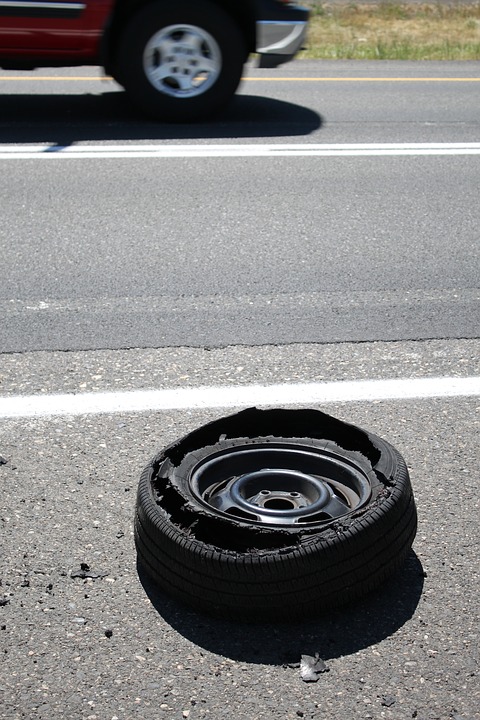 On top of that, you can end up with a punctured tire after a car accident, which is why you want to do an in-depth inspection of the vehicle after any impact.
On top of that, you can end up with a punctured tire after a car accident, which is why you want to do an in-depth inspection of the vehicle after any impact.
For the tire to hold the weight of your vehicle, it must be properly inflated. If the tire is underinflated, it won’t have the air pressure needed to hold the vehicle’s weight. However, the opposite is also a problem. When the tire pressure is too high, it puts an excessive amount of pressure on the sidewall, possibly causing a blowout or puncture because of the stress.
Find the appropriate psi for your car tires on the label inside the driver’s side door jamb. If you still aren’t sure, it’s best to ask for guidance from your local tire shop. Many of these locations will perform regular air pressure testing for free to regular customers.
RELATED: How to Find the Correct Tire Pressure For Your Car (4 Steps)
3. Old AgeTires that sit unused are susceptible to tire dry rot.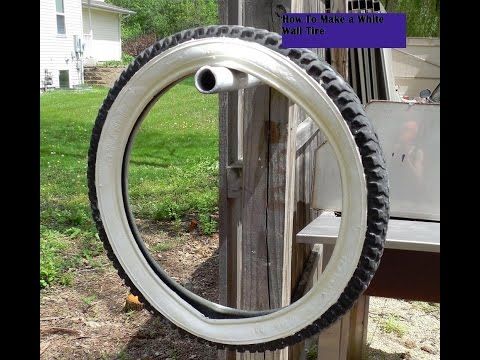 This occurs even more frequently when the tires sit in the sunlight.
This occurs even more frequently when the tires sit in the sunlight.
Additionally, old age, in general, can cause a tire to degrade. If the tire has been around for more than ten years, it might be time to consider replacing them. Although, it’s best to start inspecting the tires more regularly once they reach five years old.
4. OverloadingYour car tires are only meant to have a certain amount of weight on them. You can find this information found in the owner’s manual or on the driver’s side door jamb.
If you exceed this weight, it can cause too much pressure on the tires. This added weight leads to a breakdown of the tire sidewall and tread, causing a puncture or blowout.
5. DefectsThere’s always the chance that the tires were put on the vehicle with manufacturer defects. While this isn’t common, it has happened.
To prevent this, you want to be careful what tires you install on your car. It’s tempting to put the cheapest tires possible on your car, especially when money is tight.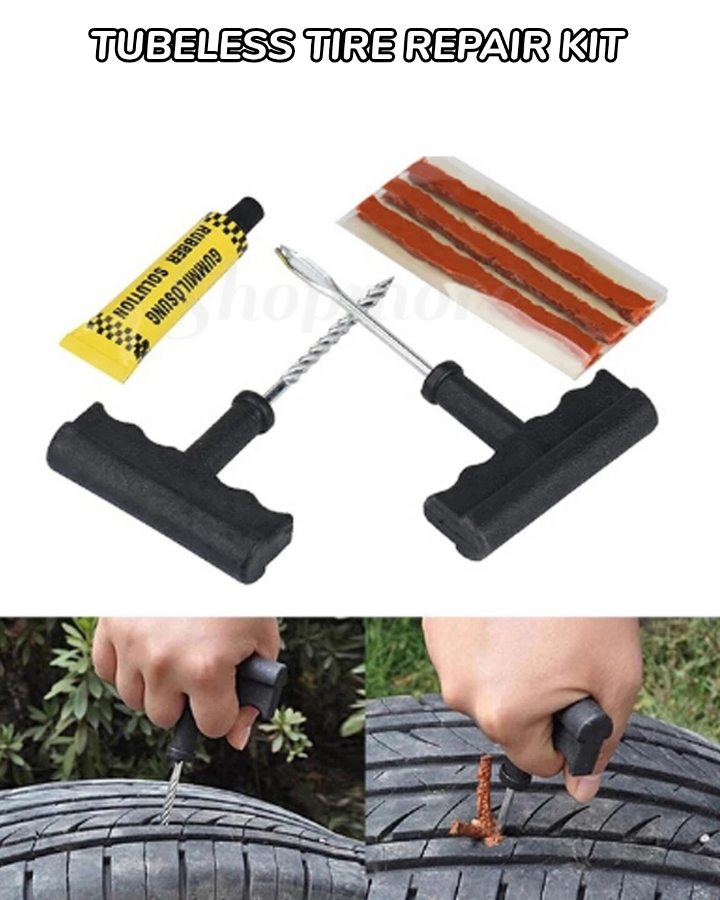 However, the savings will mean nothing if the tires fail you and cause an accident.
However, the savings will mean nothing if the tires fail you and cause an accident.
For a tire puncture to be repaired, it must meet certain criteria. While some people will attempt to repair punctures in other circumstances, it’s not always recommended. Reputable tire shops will only patch or plug a tire that matches these criteria:
If all of these requirements can’t be met, there should be no repair. Instead, a tire replacement would be the only safe option. Depending on the condition of your other tires, you might need to replace more than one to keep things uniform.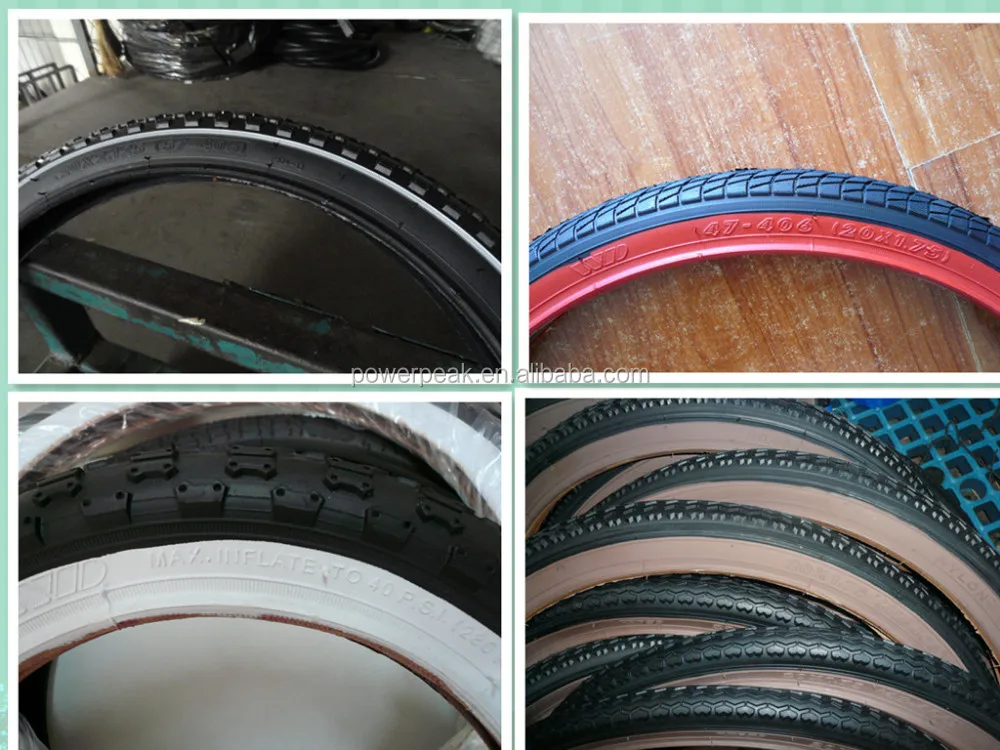 However, if these requirements are met, you could repair it. Follow the advice of most professional tire shops and use a patch-plug kit for the best results.
However, if these requirements are met, you could repair it. Follow the advice of most professional tire shops and use a patch-plug kit for the best results.
If you use a tire plug, it might last seven to ten years when done properly and care is taken. It’s designed to last a minimum of 25,000 miles. However, for the plug to be successful there must be a proper seal between the material and the tire tread.
Patches could last a little longer and are generally seen as the more reliable option. It could last the life of the tire as long as the repair is performed properly. If you get the patch installed at a shady shop or it’s done in a place where it doesn’t belong, it could fail prematurely, leaving you with bigger troubles.
Ideally, you would combine the two for the best fix. Use a plug and patch for maximum protection.
RELATED: How Much Does It Cost To Get a Tire Patched?
One of the problems you can encounter when traveling by car is a punctured tire. Using a patch is a fairly common option to work around this issue.
Yet, if the hole is in a position like a tire wall, the problem becomes much more complicated because it is likely that the defensive position will not be patched.
So, how close to the sidewall can a tire be patched? A distance of 6 mm or more from the tire shoulder is required to fit a patch. In other words, if a crack is closer than 6mm, there’s almost nothing you can do about it!
Tire Sidewall OverviewFirst, let’s learn about sidewalls and how to identify them on your tires.
The wall is the rubber part from the outer edge of the rim to the road surface. This part also has the largest area, is the most flexible, and continuously deforms under loads when moving.
This part also has the largest area, is the most flexible, and continuously deforms under loads when moving.
As you know, the car’s wall is in a particular location, so it is pretty challenging to troubleshoot the hole here.
Manufacturers also recommend that you not choose the patch option if the spot is on the side of the vehicle or too close to this position. Then, how close to the sidewall can a tire be patched.
You cannot use the patch if the hole is close to the wheel with a gap of less than 6mm. In addition, you should note that if the hole is more significant than ¼ inch, the patch should not be used. In this case, if the patch is small, it cannot cover the hole, causing the wheel to deflate still when moving.
On the contrary, using a large patch can make the wheel more bulky, difficult to move, and unsafe.
Fix Sidewall DamageOther Related QuestionsTo better understand the problems that occur with the tires and how to overcome them effectively, you can refer to the following information.
We’ve put together some frequently asked questions that may help answer your questions on this topic.
Plug a flat tire: Is it possible?People are often concerned about whether it is safe to plug or patch a flat tire.
These two options are pretty standard in repairing or overcoming the problem of flat tires caused by rolling nails or other sharp objects.
The manufacturer still recommends that you better replace the tire with a new one when there is a problem because repairing with a plug or patch when a flat one is not a safe solution.
Yet, the cost of new tires is not cheap, and if you have this problem often, it is a big problem. So, many drivers use a plug or patch when a wheel is punctured.
So, many drivers use a plug or patch when a wheel is punctured.
There is a limit to the number of nails or patches on a product. You can use this option to temporarily fix the problem if you find a few small holes. If the wheel has many large holes or previous patches, it is best to replace it with a new one.
For a detailed guide, check out this video:
How close can a tire patch be to another patch?The gap between patches is also a topic that people are very interested in. When traveling on the road, you may encounter a flat one many times.
As you know, when the tires have had previous patches or punctures in close locations, it is better to replace them. In case
In case
In the case of a puncture on the tire side, the use of stickers is unlikely to have as much effect as you think.
The reason is that its wall adhesion is so thin that relatively few materials can adhere. More specifically, damage to the sidewall will seriously damage the structure of a wheel.
The solution to this problem is to insert an extra tube inside the wheel to ensure that you can still turn the whole thing.
How fast can you drive on a patched tire?A patched one will not achieve the same speed and performance as it once was. Therefore, the optimal level you can expect from such a version will not be more than 85 mph. Of course, this is just the limit that many manufacturers recommend, but you should not overdo this limit.
Can you patch a tire with 2 nails in it?The answer is yes! It’s just that the gap between the two punctures is at least 16 inches, and you might seal them with two large patches.
According to many manufacturers, the maximum number of times performed is two times. If more than that, it’s time to get a new one.
ConclusionAs such, a puncture in the side of the vehicle is a unique location where patching is not an optimal solution in this case. It would help if you changed to a new tire to ensure safety when traveling.
Thank you for following this post!
This post was last updated on You got it: the tire is flat, but there is no spare tire. Modern tires are tubeless - if you managed to block a small leak with a sealing compound, pouring it into the valve, you can not look for a puncture. Effectively - plug the hole with a rubber band. It is injected from the outside with a special device (such kits are inexpensive on the market).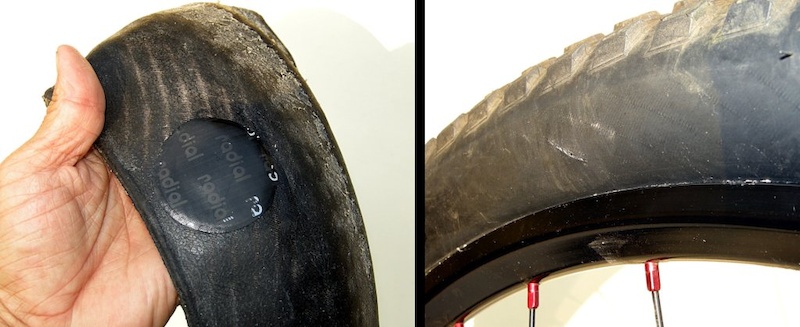 But now we are talking about an extreme case - when a careless driver has nothing at hand to quickly repair a puncture.
But now we are talking about an extreme case - when a careless driver has nothing at hand to quickly repair a puncture.
The technique is not new, but effective: we move the tire bead using the weight of the car and the force of the jack.
The technique is not new, but effective: we move the bead of the tire using the weight of the car and the force of the jack.
A small hole can be plugged by screwing a self-tapping screw into it. You can take it, for example, from the trunk lining. Another option, if the puncture is small: pour half a liter of water into the tire (with a pump through the valve) so that it slows down the air outlet. But periodically you will have to pump up the wheel.
Approximately ten cubes of gasoline, a torch, an explosion - and the board sits still!
Approximately ten cubes of gasoline, a torch, an explosion - and the board sits still!
To seal a large hole, the tire will have to be removed from the rim, at least on one side.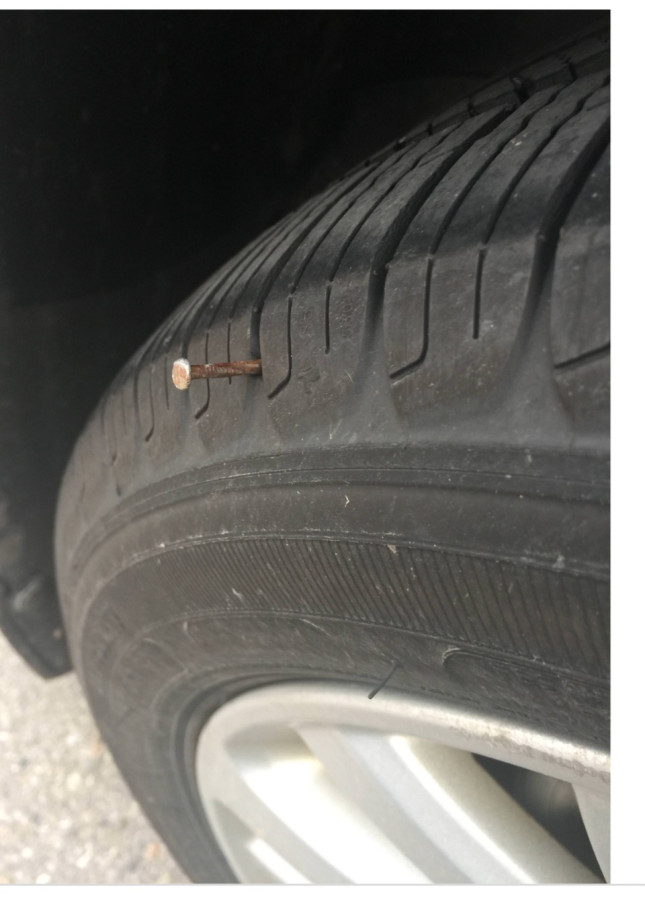 But first, move both tire beads deep into the rim groove. Experienced people carry a piece of steel angle and a heavy hammer for such a case. Or they move it with a jack, resting its heel against the sidewall of the tire, and the shelf against the threshold of the car. Next, installers need to drag the desired bead over the rim flange, and only after that you can take on repair fungi, glue and patches.
But first, move both tire beads deep into the rim groove. Experienced people carry a piece of steel angle and a heavy hammer for such a case. Or they move it with a jack, resting its heel against the sidewall of the tire, and the shelf against the threshold of the car. Next, installers need to drag the desired bead over the rim flange, and only after that you can take on repair fungi, glue and patches.
The puncture has been repaired - but how to return the tire to the rim shelves? Not everyone has a high-performance electric compressor with them. And in order to use a conventional pump, you will have to seal the gaps as much as possible - for example, pull the tire around the circumference with ropes. If the sides hit the hump and the pressure began to rise, the problem is solved. In practice, these methods require manual dexterity. It's easier to land the tire with a light blast. This requires 10–15 g of gasoline. Pour a few milliliters of fuel inside the tire, then, so that it evaporates better, we roll the wheel. We put it on its side and, pressing on the sidewall, bring the flame to the gap. But not a match, but a torch! There will be a pop - and the tire is in place. A typical mistake is to pour too much gasoline: instead of popping, a fire will break out. We extinguish, we air ...
We put it on its side and, pressing on the sidewall, bring the flame to the gap. But not a match, but a torch! There will be a pop - and the tire is in place. A typical mistake is to pour too much gasoline: instead of popping, a fire will break out. We extinguish, we air ...
“Inflate” the tire with a watering hose. The matter requires patience, but on such a wheel you will reach the place of repair.
"Inflate" the tire with a garden hose. The matter requires patience, but on such a wheel you will reach the place of repair.
When the hole is in the knuckle, the tire cannot be salvaged. Unless you insert a camera into the tire. From the inside, it is useful to cover the hole with a "coat" of a couple of layers of rubber or with a bandage cut from the sidewall of a tire lying on the side of the road - there is a lot of this goodness along the roads. This will protect the chamber from sand and reduce the chance of further tearing.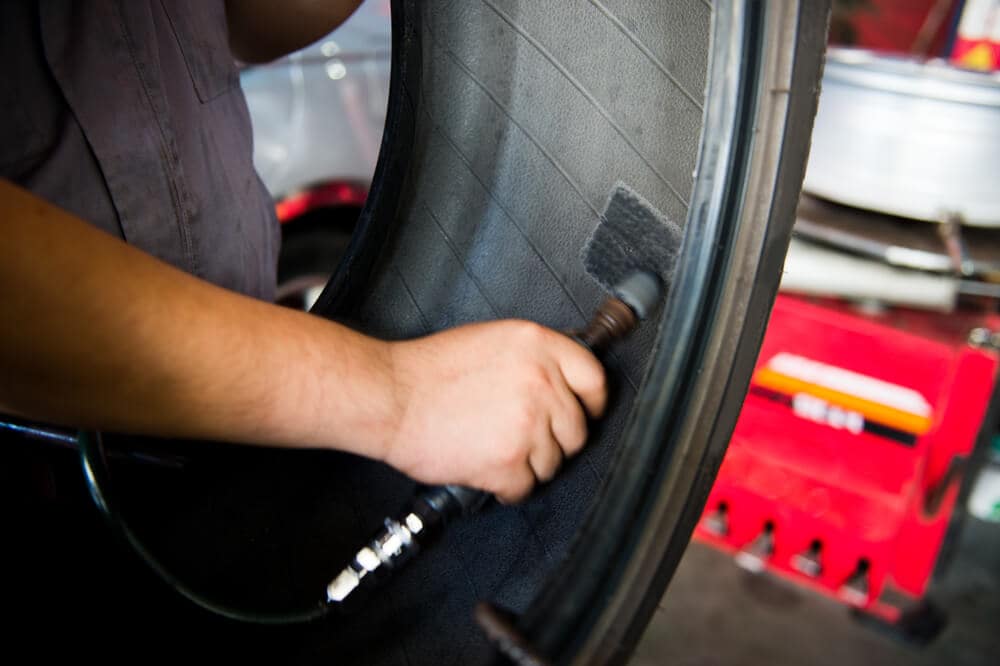 And if it's not far from the purpose of the trip? On a flat tire, you can drive 15–20 km on asphalt at speeds up to 40 km/h before it finally falls apart. We talked about this experiment in ZR, 2009, No. 7.
And if it's not far from the purpose of the trip? On a flat tire, you can drive 15–20 km on asphalt at speeds up to 40 km/h before it finally falls apart. We talked about this experiment in ZR, 2009, No. 7.
But what if there is no camera? Then turn on the fantasy. Someone "fills" the tire with a watering hose; all sorts of rags, sponge rubber from old seats, plastic film, linoleum strips, sidewalls cut from old tires, etc. will be used. With such stuffing, tires will wrinkle less on the go. But forget about driving in normal mode - slowly, extremely carefully, we drive to the nearest tire shop.
Travel kit: wedges, jack, pry bars, wheel wrench, hammer, gloves, corners, compressor. Do not forget repair fungi, self-vulcanizing patches and, of course, a valve cap with a head that is used to unscrew the spool. There are usually no such caps on the wheels of modern cars, but if you look, it may come in handy.
Travel set: stop wedges, jack, pry bars, wheel wrench, hammer, gloves, corners, compressor.![]() Do not forget repair fungi, self-vulcanizing patches and, of course, a valve cap with a head that is used to unscrew the spool. There are usually no such caps on the wheels of modern cars, but if you look, it may come in handy.
Do not forget repair fungi, self-vulcanizing patches and, of course, a valve cap with a head that is used to unscrew the spool. There are usually no such caps on the wheels of modern cars, but if you look, it may come in handy.
CARE OF THE WHEELS, RULES OF DISMANTLING AND ASSEMBLY
— Not all tire damage can be repaired without loss of its qualities. Drive in such a way that the risk of fatal injury is minimized. On a long journey, take a camera in reserve - it can come in handy.
- Monitor the condition of the wheelbrace and jack. Cracks or metal extrusion, heavily worn threads, tight rotation despite lubrication are unacceptable!
— Before jacking up the vehicle, secure the wheels on the opposite side. Stoppers under the support wheels - wedges, stones, etc. - should not slip along the road. To prevent the machine from sliding to the side, it is better to place the support wheels in shallow ruts or pavement potholes.
- If you have to work on soft ground or snow, place a wider support under the heel of the jack - for example, a piece of durable board. When turning the screw, do not adjust the jack with your other hand, especially do not stick your fingers into it. After lifting the car, for insurance, place a reliable additional support under the threshold (spare wheel, stable block of wood, etc.).
When turning the screw, do not adjust the jack with your other hand, especially do not stick your fingers into it. After lifting the car, for insurance, place a reliable additional support under the threshold (spare wheel, stable block of wood, etc.).
- When installing the wheel, the bolts (nuts) of the fastening must be tightened still on the weight - so it will be correctly centered on the hub.
- The threads of mounting bolts (nuts) will last longer if you lightly grease them before tightening them.
Roadside tire service
Roadside tire service
Author: Aleksey Kokorin
Experienced drivers are not surprised by such a trifle as a puncture, but for the first time beginners usually get confused in the sequence of actions, forget about important details and do not know what to do with a punctured wheel even in a tire shop - especially if they start offering choose from several options or intimidate with expensive repairs. Let's set up an operation algorithm when a flat tire is detected and figure out what to do right away and what to choose later.
Let's set up an operation algorithm when a flat tire is detected and figure out what to do right away and what to choose later.
What to do when you find a puncture
Having found a flat tire, first of all, you need to stop in a safe place, turn on the emergency alarm, assess visibility and, if necessary, set an emergency stop sign: according to traffic rules, it is installed at least 15 meters from the car in built-up area and at least 30 meters outside the built-up area. When choosing where to stop, consider the space to the side of the vehicle to handle a flat tire. You should not stop right on the road and in places where stopping and parking are prohibited: even if a punctured wheel belongs to the conditions of a forced stop, it is quite possible to drive several tens of meters on it to choose a safe and convenient parking place. At night or in conditions of limited visibility (for example, in fog or rain), it is imperative to wear a vest with retroreflective elements - this is required by clause 2.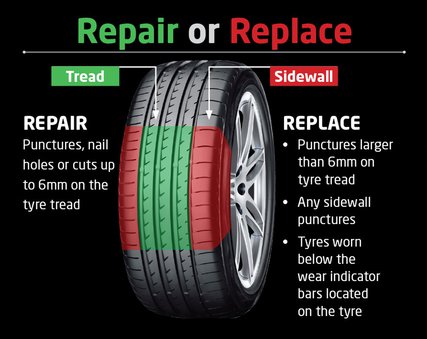 3.4 of the SDA and common sense.
3.4 of the SDA and common sense.
Now you can start working on the wheel. We will sequentially consider several options for action, and then move on to ways to repair a damaged tire.
The most obvious solution to a flat tire is to replace it. If you have a spare tire that you are sure is in good condition, the best option is to install it and visit a tire shop to repair a punctured tire - such repairs will be more reliable and of high quality than doing it yourself.
If you do not have a suitable spare tire, but you do have a pump or compressor, you can assess the damage to the tire and try to pump it up again to get to the tire shop. It is better to start searching for an air leak with a valve (aka “nipple” or “nipple”): often a faulty spool becomes the cause of a flat tire. It is easy to check it: unscrew the protective cap (if there is one), pour water on it (or slobber it, as in childhood): air bubbles will leak. In this case, you can try to replace the spool valve by unscrewing it and screwing in a new one, but if there is no new valve, as well as a store nearby, you can try just unscrewing and screwing it back in. Regardless of whether it helped or not, you need to visit a tire shop to replace the entire spool or valve.
Regardless of whether it helped or not, you need to visit a tire shop to replace the entire spool or valve.
If the valve is tight and the tire is flat, it is most likely a puncture. The easiest way to find a puncture that is free of foreign objects is to pour water on the tire while looking at the surface: the damage will reveal itself as air bubbles. However, often the cause of the puncture can be found along with it: a self-tapping screw, nail or other arbitrary object sticking out of the wheel will clearly indicate the place of depressurization. In this case, you do not need to immediately remove the foreign object from the tire: it partially seals the hole, and if the pressure loss is slow, you can try to pump up the wheel and drive to the tire shop.
The same goes for wheels that are leaking from the rim or from a faulty valve. Usually, in this case, the air is bled slowly, and you can pump up the wheel and have time to get to the place of repair. By the way, rim leakage can occur due to disk deformation upon impact - for example, when hitting a pit with sharp edges.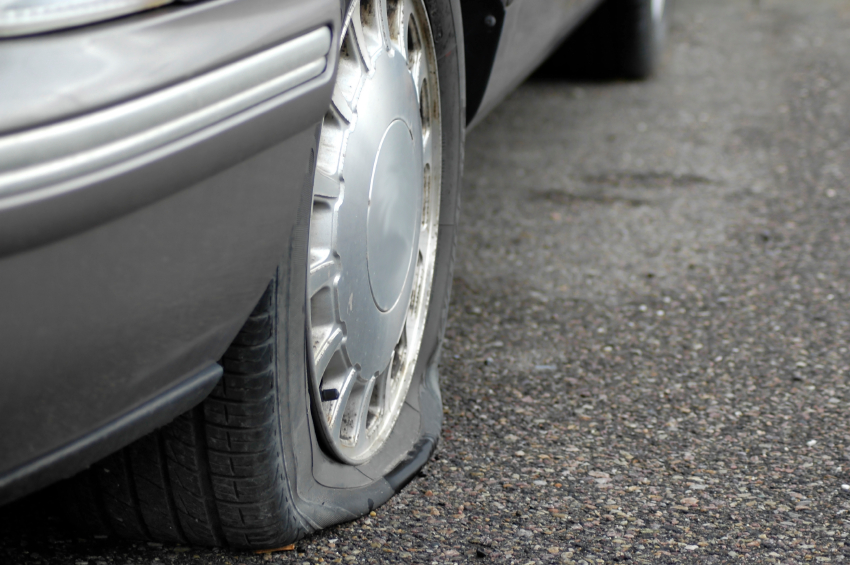 Such situations are fraught with damage to both the disk and the sidewall of the tire, in which case the disk will need to be corrected, and the tire repaired or even replaced. To avoid rim leaks, you need to inspect the rims every time you change tires. The loss of tightness occurs either due to corrosion or due to disc deformation, and not only steel, but also light alloy wheels can corrode. So if you see paint blistering or rust on the rim, the tires need to be put on rim sealant: when changing tires, this will be cheaper than the subsequent removal and re-tire to fix a leak on the rim.
Such situations are fraught with damage to both the disk and the sidewall of the tire, in which case the disk will need to be corrected, and the tire repaired or even replaced. To avoid rim leaks, you need to inspect the rims every time you change tires. The loss of tightness occurs either due to corrosion or due to disc deformation, and not only steel, but also light alloy wheels can corrode. So if you see paint blistering or rust on the rim, the tires need to be put on rim sealant: when changing tires, this will be cheaper than the subsequent removal and re-tire to fix a leak on the rim.
If you find a puncture, but there are no foreign objects in it, and you do not have a spare wheel and tire repair kits, there is another popular method of temporary "repair". You can screw a self-tapping screw into the found hole - if, of course, you have one. In extreme cases, you can look for a self-tapping screw in the cabin by unscrewing it from some interior detail. This method cannot be called reliable: it is unlikely to ensure complete tightness of the wheel, but at least it can help you get to the nearest tire shop.
And a couple more useful remarks. If the wheel is completely flat, then it is easier to inflate it without a spool: the latter must be unscrewed, then the tire must be inflated and quickly screwed back in. The fact is that the spool itself, when inflated, resists the compressor, and in the event of a loose fit of a flat tire to the disk, the power of a simple magazine compressor may not be enough, and the absence of a spool helps to increase air flow and facilitate the operation of the compressor. If this does not help, you can jack up the car by hanging a flat tire: this will improve the fit of the tire to the disk, and the chances of inflating the tire will increase.
On-Site Repair Methods
Now let's look at the options for repairing a tire yourself using special materials that you should take with you or, if a puncture caught you in the city, buy at the nearest car shop.
1. The most common, cheapest and easiest way to do it yourself is to install a raw rubber band. The harnesses are sold complete with an abrasive awl to expand the hole in the tire and improve the contact of the repair harness with its edges, as well as a needle for installing the harness and an adhesive to fix it and at the same time seal the puncture. When choosing a repair kit in a store, you should pay attention to the following nuances:
The harnesses are sold complete with an abrasive awl to expand the hole in the tire and improve the contact of the repair harness with its edges, as well as a needle for installing the harness and an adhesive to fix it and at the same time seal the puncture. When choosing a repair kit in a store, you should pay attention to the following nuances:
Install the harness in the following order. First, the found hole is expanded with an abrasive awl - you need to insert and remove it several times into the puncture site. Then the tourniquet is inserted into the eye of the needle, and glue is applied to it. After that, the needle with the tourniquet must be inserted into the hole in the tire and pulled out sharply - so that the tourniquet remains in the hole, and the needle comes out without it. If everything worked out, it remains only to cut the end of the harness flush with the surface of the tire and pump up the wheel.
If everything worked out, it remains only to cut the end of the harness flush with the surface of the tire and pump up the wheel.
The advantages of repairing with a harness are quite decent reliability, simplicity and low cost. On a well-repaired tire, you can drive for a long time, and if the repair site starts to poison, you can either replace the harness or have the tire repaired in a quality service. Among the minuses is the possibility of damaging the cord during installation, as well as lower reliability compared to “full-fledged” repair methods in a tire shop. Strictly speaking, a tourniquet is still a temporary repair, so if it is possible to pump up a wheel and get to a tire fitting, then it is better not to enlarge the hole in the tire and get to the experts.
2. The second repair option is aerosol liquid sealants sold in cans. To repair a punctured tire with sealant, you need to remove the foreign object from the puncture site, then pour the sealant into the wheel through the valve, twist it to distribute the composition inside the tire, pump up the wheel and drive several kilometers at low speed for the final uniform distribution of the sealant.
The advantage of this repair is that it is easier and less labor intensive than installing a harness. However, there are also disadvantages: the larger the hole, the higher the chance that the sealant will not be able to eliminate it, and such a repair can affect the wheel balance. Compared to a tourniquet, it can be considered even less reliable and preferable, but simpler.
Repair options at a tire shop
If you put on a spare tire and brought the wheel to a tire shop, you may also be offered several repair options. Consider the most popular with an indication of the advantages and disadvantages.
1. The first repair method is the same harness installation as described above. As we remember, the tourniquet refers to a temporary repair, so among tire specialists this method is considered bad form, but many workshops do not exclude it from the list of services. All the advantages and disadvantages are the same here: such a repair will be the fastest, simplest and cheapest, but less reliable than other methods. It is worth choosing it in cases where the price and / or speed of the procedure is more important to you than anything else. If quality is a priority, then it is better to fork out for the options listed below.
It is worth choosing it in cases where the price and / or speed of the procedure is more important to you than anything else. If quality is a priority, then it is better to fork out for the options listed below.
2. The second option for repairing a puncture is to install a patch on the inside of the tire, the so-called cold vulcanization. In this case, the tire is removed from the disk, the surface around the puncture is treated with an abrasive, and the damage is sealed with a special patch. This is a more preferred repair method than a tourniquet: it is more reliable and durable, especially in the case of side punctures, when not the thick tread part of the tire is damaged, but the thinner sidewall. Among the minuses, only a higher cost can be noted: in addition to the actual tire repair, you will have to pay for the removal and installation of the wheel (or do it yourself), tire fitting and balancing.
3. The third option is a "complex" of the first and second: installation of the so-called repair "fungus". The “hat” of the fungus is a patch, and the “leg” is threaded from the inside of the tire to the outside. After gluing the patch, the excess part of the leg is cut off, as in the case of the tourniquet. Thus, not only the inner surface of the tire is closed, but also the hole itself. The advantages and disadvantages of this repair method are generally the same as those of a patch.
The “hat” of the fungus is a patch, and the “leg” is threaded from the inside of the tire to the outside. After gluing the patch, the excess part of the leg is cut off, as in the case of the tourniquet. Thus, not only the inner surface of the tire is closed, but also the hole itself. The advantages and disadvantages of this repair method are generally the same as those of a patch.
4. An extreme, “emergency” measure when repairing a punctured wheel is to install a camera in it. Typically, this method is used for tires that are no longer worth repairing, or “for reliability” after repairing a complex puncture. It should be understood that almost all modern tires are tubeless, that is, they are not designed to install a camera, so it’s not worth driving a wheel repaired in this way for a long time. Installing a tube is a temporary solution for riding until a new tire is purchased, and sometimes such wheels are left as spares. So this repair method can be kept in mind as a backup.
Finally
We have deliberately left out of the scope of this text such methods as combined repair of tires with a tourniquet and a patch and hot vulcanization. The first is used quite rarely and for specific damage, and it is enough just to know about its existence. Well, the second is used to repair serious side cuts, and it is not only rare, but also very expensive. The cut site in this case is prepared, filled with raw rubber and processed with a hot press for vulcanization. Equipment for this procedure is not available in every tire shop, and the cost of repair can be about half the cost of a new tire.
interesting popular questions
Articles / Practice Do I need to warm up the car before driving in winter: we understand in detail In my personal rating of debatable and provocative topics, the articles “how to warm up a car in winter” take an honorable first place in terms of the number of absurdities, mistakes and other shortcomings. T... 353 0 one 11/22/2022
T... 353 0 one 11/22/2022
Articles / Auto and technology Just like Russian: the path of oil from the well to the consumer with your own eyes Two experienced travel bloggers, Alexey Zhirukhin and Sergey Lysenko, as part of an exciting fourteen-day tour of 12,000 km, will learn the whole way of obtaining oil - from a well to... 281 0 3 11/22/2022
Articles / Popular questions Not only dangerous driving: how and why traffic rules prohibit frequent lane changes Many people associate frequent rebuilding on the road only with dangerous driving, which, as you know, is prohibited by traffic rules. However, in fact, rebuilding is regulated even in conditions where ... 562 0 one 11/21/2022
However, in fact, rebuilding is regulated even in conditions where ... 562 0 one 11/21/2022
Test drives / Test drive Haval Dargo vs Mitsubishi Outlander: the dog is barking, the stranger is coming In the Haval dealership in the south of Moscow, life is in full swing: buyers look at cars, communicate with managers and sign some papers. While I was waiting for the test Dargo, the same cross... 17110 7 205 13.09.2022
Test drives / Test drive Motor from Mercedes, emblem from Renault, assembly from Dacia: test drive of the European Logan 1.